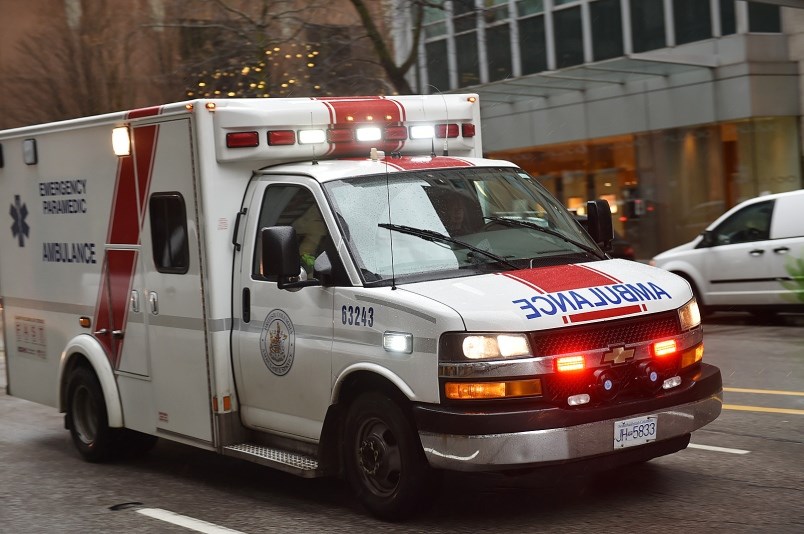Paramedics had their busiest day ever in B.C. last Friday in responding to overdose calls —131, which is roughly double the average number of calls answered in a single day across the province.
The calls were spread from Vancouver’s Downtown Eastside, which generated 15, to Langford on Vancouver Island with six and Kelowna with seven. Surrey had 14 and Haney recorded four.
Why the increase?
Data from the B.C. Coroners Service, B.C. Emergency Health Services and the Vancouver Police Department, along with insight from a public health doctor, suggest a combination of factors that explain the spike.
The main driver is a higher concentration of fentanyl being found in the illegal drug supply, with 119 of the 170 deaths recorded across the province in May connected to the deadly synthetic opioid.
Those 170 deaths were the highest ever recorded in a month in B.C.
That sobering statistic makes the news about the number of overdose calls responded to June 26 not unexpected, said Dr. Mark Lysyshyn, the deputy chief medical health officer for Vancouver Coastal Health.
“I’m not surprised because I know we’ve been seeing a lot of overdose deaths, and know that the toxicity of the drugs are going up,” Lysyshyn told Glacier Media Tuesday. “That has been the cause of this overdose crisis throughout the entire public health emergency and we’ve done nothing to change that.”
The most recent coroners service report revealed that post-mortem toxicology tests showed a greater number of cases with “extreme fentanyl concentrations” in April and May compared to previous months.
Testing in those two months found approximately 19 per cent of cases had extreme fentanyl concentrations, as compared to nine per cent from January to March.
Lysyshyn suggested the pandemic’s influence on tighter border controls has led to more manufacturing of fentanyl in Canada by people unfamiliar with setting potency of the drug.
Another worry for Lysyshyn has been the increased contamination of opioid drugs with illicitly-made benzodiazepines, with high rates of detection of the deadly combination seen over the last year.
Public health officials have also noticed a significant drop in recent months of people visiting drug injection facilities, overdose prevention sites and treatment clinics because of fears associated with the spread of COVID-19.
In Vancouver, police told Glacier Media in an email Tuesday that 81 per cent of the overdose deaths in the city since March involved people using drugs alone, meaning no one was with the person to administer the overdose-reversing drug naloxone, or phone 911.
The correlation between many drug users receiving their monthly social assistance cheque on a Wednesday and spending it to buy drugs over the next couple of days has long been a concern of public health officials and harm reduction advocates.
That reality, which has been documented in coroners service reports, is another likely factor in the 131 calls paramedics answered last Friday, said Lysyshyn, noting the call volume came two days after what is more commonly known as cheque day.
“It does cause surges of overdose, and we’ve long advocated to break up that distribution [of cheques] in some way to try to allow the system to handle overdoses better,” he said.
B.C. Emergency Health Services did not have statistics on how many, or if any, of the people who overdosed Friday died, but said in an email that patients have a 99 per cent chance of survival when responded to by paramedics.
But Brian Twaites, a paramedic specialist who responds to overdoses and works in the Vancouver dispatch centre, said reviving overdose victims is requiring higher doses of naloxone.
“Overdoses are getting more intense,” he said in an email to Glacier Media. “So the entire time, they’re not breathing. So we’re going to be ventilating these patients for a longer period of time and waiting for [the naloxone] to respond.”
Overdose calls responded to by paramedics fluctuated between 10,000 and 15,000 per year between 2004 and 2015. But in 2016, when fentanyl entered the street drug supply, paramedics saw a dramatic increase in overdose call volumes and reached more than 23,000 per year by 2017.
In Vancouver alone last year, paramedics responded to 8,589 calls, which was up from eight per cent over 2018. Vancouver was followed by Surrey with 2,151 calls and Victoria with 1,412. All three cities have year over year recorded the highest number of overdose deaths.
The previous record for overdose calls answered by paramedics in one day was 130, which occurred twice — first on April 26, 2017, and a second time on July 27, 2018.
The coroners service released a report two weeks ago that detailed the mode that drugs were being consumed in the province. A review of overdose death cases from Jan. 1, 2016 to Dec. 31, 2019 found that more people died from smoking illegal drugs than injecting them.
In 2016, injection was the most common way users took their drugs. From 2017 onwards, smoking has become the most common mode, with injection use declining from 37 per cent in 2016 to 25 per cent in 2019.
Smoking increased from 28 per cent to 40 per cent during the same period. Snorting, or intranasal use, saw slight declines each year, from 26 per cent in 2016 to 20 per cent in 2019. Evidence of multiple modes of consumption was found in about 14 per cent of cases each year.
The report warned, though, the data is not complete, with a “proportion of unknown cases,” citing the difficulty of collecting information, as there may be no evidence at the scene of the death, no witnesses or the death occurred in a hospital.
@Howellings



